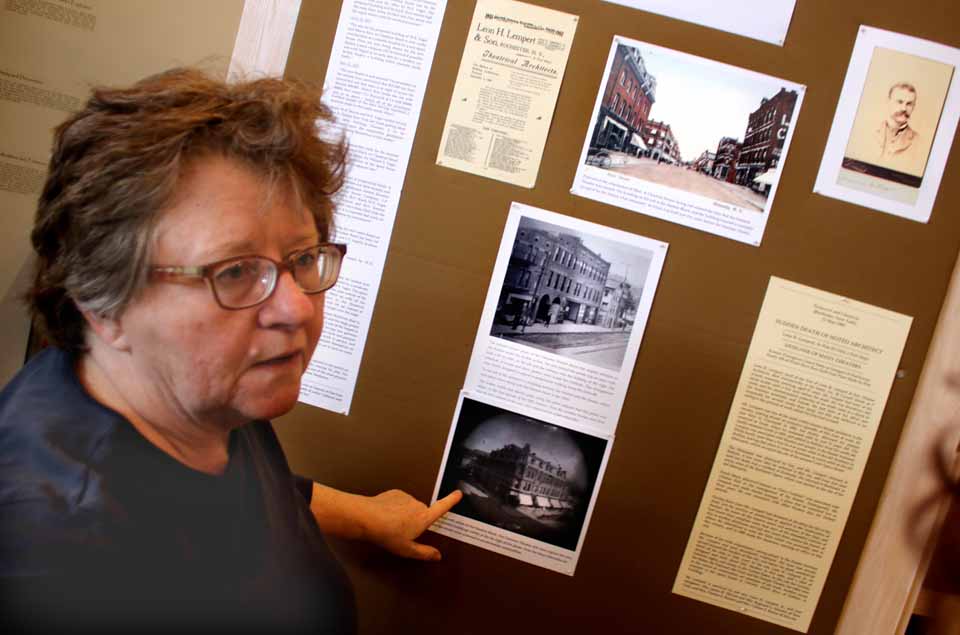NEW DISPLAY AT GOHS
Exhibit Dramatizes Once
(And Future?) Theater

By LIBBY CUDMORE • Special to www.AllOTSEGO.com
ONEONTA – If we want to save the Oneonta Theatre, Patrice Macaluso says, we cannot just look to the past.
“It has always changed with the times,” she said. “We can’t get wedded to what it was.”
The changing face of the Oneonta Theatre is the subject of the Greater Oneonta Historical Society’s newest exhibit, “The Oneonta Theatre: Reflecting Popular Culture Since 1897,” curated by Macaluso.
The exhibit traces the whole history of the venue, from the very first show in 1898 – “The Sporting Dutchess” starring Madame Modjeska, the most famous actress of the day – up to the present, where a recent marketing study and feasibility study hold the key to whether the downtown institution can be saved – or not.
“The business plan is a reality,” she said. “But whether or not we can sustain the funding has not yet been determined.”
The Oneonta Theatre was the brainchild of Willard E. Yager, Oneonta Herald publisher, also an advocated of the Oneonta Normal School founding. He led the fund drive for the theater in 1897 and oversaw its construction.
The opera house was strategically located across from the Windsor Hotel (now the site of TownSquare Media and NBT Bank), which housed many of the actors who came in by rail to perform.
The theatre boomed during the days of vaudeville, isted in Julius Cahn’s Official Theatrical Guide,” the Bible for booking agents and traveling performers looking to a place to put on a show. It also listed critics, advertising agencies, and doctors available to treat actors who fell sick on the road.
In addition to musicians and theater, the Oneonta hosted fundraisers, including the popular “Womenless Weddings.”
“All the important men in town would dress up in women’s clothes,” said Macaluso. “It was a fundraiser for the Rotary and Kiwanis clubs.”
One such event packed the house, but the Oneonta was frequently packed in those days. “The theater was so popular they had to expand in 1919,” she said. “I always wondered why there was the new ceiling; they took the stage house down and moved the stage back 20 feet.”
The first movie screen was installed in the late 1920s, featuring Warner Bros.’ early Vitaphone movies – a phonographic record that synched to the film – in 1929. “They were usually repurposed silent films that had previously used a live orchestra,” she said.
The Schine company bought the Oneonta in 1933, adding to a chain of what would later be 145 theaters across Upstate New York, a monopoly later broken up by a U.S. Supreme Court case.
Escaping demolition in the 1960s Urban Renewal era, the theater was sold to Harold DeGraw, who also built the Showcase Cinema, where Silks & Treasures is now. Later, the theater was sold to Terry Mattison, the longtime manager.
In 2008, entrepreneur Tom Cormier of Burlington Flats bought it, and although he initially worked with the Friends of the Oneonta Theatre – Macaluso made the new marquee letters herself – he parted ways with the group shortly after opening.
“We had a grand from Senator Seward, but it was rescinded because Tom wasn’t running it as a non-profit,” said Macaluso. “We were disappointed.”
But in 2017, Cormier closed the theater and put it up for sale.
Following the study in February, the success of the Oneonta Theatre, Macaluso said, is in determining what the community needs the space to be.
Cormier marketed the venue as a music club, a turn that Macaluso believes was a good choice. “I like the no seats on the floor dance space,” she said. “We could always put seats in for movies, but like that, it could be a possible venue for OH-Fest.”
She believes she has found people who are interested in fundraising, and hopes to begin a capital campaign in the near future.
“If we could just get it back into community hands,” she said. “We could build the roster of events we need to support it.”





